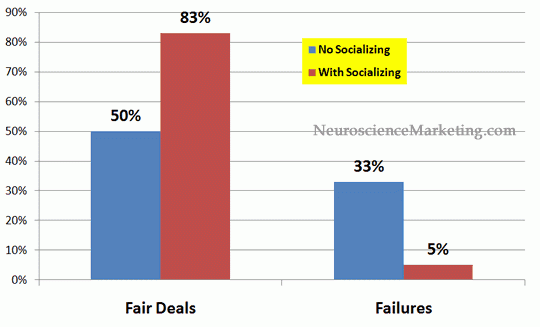The Ten Critical Minutes to Close a Deal

Trying to close a deal? Get a commitment from a big donor? Or, just build a stronger connection with someone? The most critical time for achieving that goal may be the ten minutes before you talk about business.
We’re going to combine several research findings into one strategy for closing a deal or reaching any kind of agreement.
Ten Critical Minutes to Close a Deal rgr.cc/1LlJYEq #Neuromarketing #sales pic.twitter.com/LtHdxujZeW Share on XStep 1: Allow Time to Socialize
First, we know that just ten minutes of social conversation dramatically improved the chances of a successful “deal” in the Ultimatum Game.
Nobel Prize winner (and Brainfluence Podcast guest) Al Roth showed that allowing the participants to converse socially (with no discussion of strategy or the game) prior to dividing the funds cut the number of failed deals from about a third of the total to an almost negligible 5%. (See It Really DOES Pay to Schmooze.)

This is why top salespeople never launch into their pitch right after shaking hands. Getting to know your potential partner socially, even for a few minutes, will help both of you work together to strike a successful deal.
Just 10 minutes of socializing greatly increases chances of closing a deal. #sales Share on XStep 2: Focus on the Other Person
During this socialization period, the most effective topic of conversation is… the other person!
As I described in Our Brains Make Facebook Worth $90 Billion, people love to talk about themselves because their brains reward that activity. Our brains get a dopamine boost when we talk about ourselves.

Getting your prospect to do this will put him in a more relaxed and better state of mind. Letting the other person we are with talk about himself can be difficult for many of us, of course. That’s because our own brains are seeking this same kind of reward. It’s easy to ask a question and, before the prospect has even fully answered, jump in with a story of our own.
Control your impulse to talk about yourself, at least for a while.
Step 3: Find Common Ground
The one exception to the “don’t talk about yourself” rule during this initial phase is to establish common ground.

One of Robert Cialdini’s six principles of persuasion is “Liking.” His research found that we tend to prefer people with whom we share common characteristics. The more your prospect feels that you have similarities, the more favorably disposed she will be toward accepting your ideas.
So, if you find you went to the same school, grew up in the same town, both own dogs, etc., introduce this information without taking over the conversation.
It’s possible that the better results from socializing in Roth’s experiment were due, at least in part, to the liking effect. If you give two people ten minutes to chat, chances are they will find one or more common characteristics or interests.
Be honest, though.
I recall a story, perhaps apocryphal, about a very successful auto salesperson who would always find something in common with a customer, even if he had to invent it. If the customer grew up in Detroit, he’d “remember” he had an uncle there. This might work, but don’t do it. Persuasive techniques are great, but not at the cost of your integrity.
Step 4: Add Coffee
You may not always be in control of the environment or your prospect’s choice of beverages, but if you can add a cup of hot coffee or tea to the process you’ll “warm up” your prospect further.

As I described in Heat Up Sales – With Coffee!, researchers found that holding a warm beverage made subjects rate the person they were talking to as “warmer.”
Serving someone #coffee or tea makes YOU seem warmer to them! #sales pic.twitter.com/ufPJ8jTcJP Share on XThe way to accomplish the desired result is simple: hand the person a warm beverage, preferably using a mug without a handle so he must hold the cup directly.
Even if you aren’t meeting in your office or home, there’s good news: most take-out cups from Starbucks and other coffee shops fit this description perfectly! Your prospect will appreciate your thoughtfulness when you show up with coffee or tea (find out her preference in advance), and will also be primed to find you a warm human being.
Not only will these simple steps increase your success rate when you get down to business, you’ll find you actually enjoy them. Use these ten minutes wisely!
4 Things to do in 10 Minutes to Close a Deal rgr.cc/1LlJYEq #Neuromarketing #sales pic.twitter.com/LtHdxujZeW Share on X